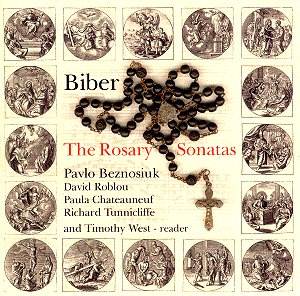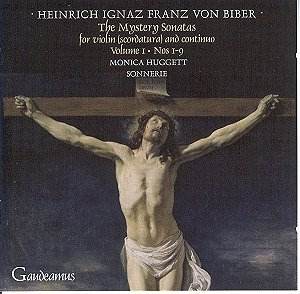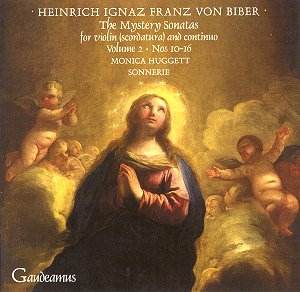The 'Mystery Sonatas'
are among the most intriguing compositions
of the 17th century. Nowadays they are
certainly the most popular of Biber's
compositions, as the number of recordings
indicates. The catalogue already contained
a handful, and at the occasion of the
tercentenary of Biber's death, another
handful was added last year, two of
which are to be reviewed here.
The collection consists
of 15 sonatas for violin and basso continuo,
with an added Passacaglia for violin
solo. The title page of the manuscript
has disappeared. Therefore it is not
known what Biber called the collection.
Nowadays they are usually referred to
as 'Mystery Sonatas' or 'Rosary Sonatas'.
The reason is that in the manuscript
every sonata is preceded by an engraving
showing stages from the life of Jesus
and of his mother Mary. These can be
thematically linked to the mysteries
of the Rosary.
The collection is divided
into three groups of sonatas: the 'Joyful
Mysteries' (Sonatas I - V), the 'Sorrowful
Mysteries' (Sonatas VI - X) and the
'Glorious Mysteries' (Sonatas XI - XV).
As the engraving which precedes the
concluding Passacaglia shows, an angel
holding the hand of a child it is often
labelled 'the Guardian Angel'.
A particular feature
of this collection is the use of the
'scordatura' technique, meaning that
one or more of the strings are retuned
as indicated at the start of the sonata.
This can hardly come as a surprise:
although Biber wasn't the only composer
to use this technique, he prescribed
it more frequently than any other. With
the exception of the first Sonata and
the Passacaglia all sonatas require
retuning, resulting in 15 different
tunings throughout the collection.
There are a number
of questions regarding these works,
which still can't be answered with certainty.
One of these is when
and for which occasion they were written
and under what circumstances they were
performed. It is thought they were written
around 1678. They were dedicated to
Max Gandolph, the archbishop of Salzburg
and employer of Biber. From the dedication
text we learn that the archbishop strongly
promoted the worship of the Virgin Mary
and Rosary devotion in particular. The
fact that these sonatas were never published
has led to the assumption that they
were written to be performed - probably
by Biber himself - in Max Gandolph's
own chapel, during his meditation about
the mysteries of the Rosary. But others
suggest they could have been performed
in the Aula Academica, the lecture hall
of the Jesuit confraternity in Salzburg.
The hall contains fifteen paintings
depicting the mysteries, and the Jesuits
strongly advocated Rosary devotion via
music.
Another question relates
to a connection between the music and
the mysteries of the Rosary. There have
been attempts to present the sonatas
as depictions of events in the life
of Jesus and his mother. Some musical
figures can be interpreted as illustrations
of particular events as described in
the Rosary psalters of the time. However
that doesn't make these sonatas 'programme
music'. One has to assume that Biber
uses affective and rhetorical commonplaces
to stimulate meditation about the mysteries.
In this regard it is
appropriate to explain the term 'meditation'.
Nowadays music presented as 'meditative'
is mostly soft and unobtrusive, allowing
the listener to dream away and sink
down into himself. However the latin
verb 'meditare' also means 'study thoroughly'
or 'practice'. In the liner notes of
Pavlo Beznosiuk's recording James Clements
writes that "by contemplating the image,
reading the texts, and hearing the music,
individuals were supposed to create
a mental picture of the mystery, often
in minute detail and at great length".
And Wiebke Thormählen, in the booklet
of Sonnerie's recording, says: "Graphic
sound painting has parallels in much
counter-Reformation art which seeks
a powerful immediacy of visualisation
with the depicted emotions, but provoking
so strong a reaction that his emotions
are heartfelt rather than merely sympathetic".
This explains the often strongly dramatic
music to be found in this collection
which is disturbing rather than 'meditative'
in the modern sense of the word.
The recordings reviewed
here have their own idiosyncrasies.
In Pavlo Beznosiuk's recording every
sonata is preceded by a reading from
three Rosary psalters held in the British
Library. This is a very nice and interesting
concept, as it provides the listener
with the spiritual context in which
these sonatas have been performed. But
one wonders whether the listener wants
to hear these readings every time he
plays the discs, even though the reading
by Timothy West, one of Britain's most
prominent actors, is outstanding in
every way. But they are on separate
tracks, so it is possible to skip them.
Whereas in Beznosiuk's
recording several instruments are used
in the basso continuo part - viola da
gamba and violone, theorbo and archlute,
harpsichord and organ - Sonnerie goes
even further in using also a lirone,
a guitar and a harp. There are different
opinions as to which and how many instruments
should perform the bass part.
The answer to this
question partly depends on where one
thinks these sonatas were performed
in Biber's time. If they were meant
to be performed at the private chapel
of archbishop Max Gandolph, then it
is very unlikely that more than one
keyboard instrument would be used, perhaps
with the addition of a string bass.
Even that practice is only based on
the indication of 'violone solo' in
the bass part of Sonata XII. That doesn't
necessarily mean a string bass is required
in all sonatas.
If one believes that
the sonatas were played in the Aula
Academica in Salzburg, then it is perhaps
possible to imagine a performance with
an additional plucked instrument. Even
so, it seems to me hardly justifiable
to use a harp and a guitar. I haven't
heard or read any evidence that these
instruments were used in Austria at
the time. And as effective the use of
the lirone, with its soft and plaintive
sound, may be in the 'Lamento', the
first section of the Sonata VI, and
in Sonata IX, this instrument - like
the guitar and the harp - was mainly
used south of the Alps.
As there are uncertainties
about the composition and the content
of these sonatas different approaches
are legitimate. And the recordings by
Pavlo Beznosiuk and Monica Huggett are
very different. This is interesting
considering the fact they are both British
and have often played in the same orchestras,
sometimes even alongside each other,
for example in the Amsterdam Baroque
Orchestra.
Pavlo Beznosiuk in
general avoids strong dramatic contrasts.
His tempi are generally slower, and
he is also more moderate in the use
of dynamics. As much as I think this
approach is defensible, I nevertheless
believe there are some major flaws in
this performance. My main criticism
relates to the legato playing and the
lack of differentiation between the
notes. The praeludium of Sonata I makes
that immediately clear: all notes get
equal weight, although it is very obvious
that many notes are only there to link
the really important notes together.
This reflects the baroque principle
of 'music as speech'. In her recording
Monica Huggett is very aware of this:
the clear differentiation between notes
is one of the features of her performance.
As a result her interpretation has a
far stronger narrative character. Baroque
music is basically telling stories,
even though we may not know the stories.
Ms Huggett also uses
a far wider range of dynamics and has
a more flexible approach to tempo. In
general her interpretation has much
more tension than Beznosiuk's, whose
performance is rather tame and pale
in comparison. Although the liner notes
try to explain - in much more detail
than the Sonnerie booklet - the content
of the sonatas and the possible descriptive
traits of them - sometimes rather speculative,
I would say - too little of that is
realised in the actual performance.
In spite of the interesting concept
of adding readings from Rosary psalters
I find it hard to recommend this recording.
Technically and from
the perspective of interpretation Monica
Huggett is vastly superior. But I have
some problems with her recording as
well. It is certainly legitimate to
approach these sonatas from a more dramatic
angle, but I feel she is going over
the top sometimes. The most striking
example is Sonata XIV: I thought I was
listening to a piece of Italian or Spanish
music, considering the strong dynamic
accents and the percussionistic playing
of the harpsichord and the guitar. It
is all very exciting, but has not that
much to do with Biber. The performance
of the basso continuo part is often
stylistically very dubious: in this
sonata the basso continuo instruments
are far too dominant, sometimes even
overpowering the violin, and there is
a continuous shift from harpsichord
to guitar and back. And in Sonata XI
it is the organ which plays a concertante
role from time to time. Overall the
basso continuo is just too much fuss
and feathers.
When I started the
listening session I was really disappointed
with Pavlo Beznosiuk's performance.
In comparison Monica Huggett's recording
was like a breath of fresh air. But
after a while I started to get annoyed
by those aspects I believe to be unidiomatic,
and in conflict with the character of
Biber's music. I was hoping Monica Huggett
would be an alternative to what was
my favourite recording so far: Reinhard
Goebel and Musica antiqua Köln
(Archiv) AmazonUK.
But I have decided that I have to stick
to Goebel: to me his recording does
most justice to all aspects of these
brilliant sonatas of one of the greatest
composers of the violin of all times.
Johan van Veen









